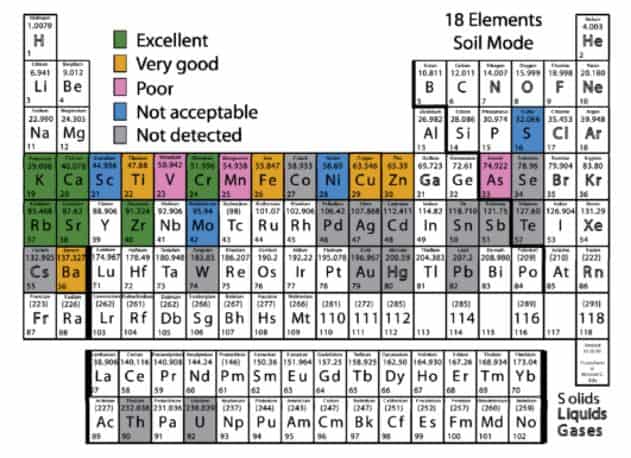At first blush, the portable XRF analyzer seems like a magical field tool for prospecting and conducting mineral exploration. While this can be somewhat true in the investigation of certain mineral commodities (in conjunction with proper sample preparation and procedure), there are other situations in which the XRF is less useful directly but can still provide great value with some knowledge and adjustments in exploration strategy.
XRF Technology
For those who are not familiar, XRF stands for x-ray fluorescence. The process whereby electrons are displaced from their atomic orbit, releasing a spurt of energy that is the signature of a specific element. The XRF records this energy release, which processes the data and categorizes it by features. Read more information regarding XRF technology in this free eBook.
Portable XRF analyzer technology is not new, although it has gone through significant refinements over the decades, especially in speed, weight, and durability with advancements in battery and computer processor technology. The first portable XRF instruments came about in 1978. Niton Corporation (now Thermo Fisher Scientific) introduced the early self-contained handheld XRF instruments in 1994. In addition to mineral exploration and mining, portable XRF analyzers have also found application in the scrap metal recycling, manufacturing, environmental remediation, consumer goods testing, and lead paint inspection fields.
1. Major Benefits to Consider
Nondestructive Mineral Sampling
With no need for acid digest, melting, or other destructive testing techniques, the XRF is a great way to quickly screen samples and test rock core directly without destroying the sample. To get an accurate result, pieces need to be homogenous, covered later in this article.
Instant Results
With adequate sample preparation, portable XRF analyzers yield high-quality analytical data comparable to laboratory results within minutes, rather than days or weeks. Portable XRF instruments simply “point-and-shoot.” While this method provides accurate results similar to those from prepared samples, the results may not be repeatable.
Field Use for Prospecting or Mineral Exploration Programs
One needs minimal training to operate a portable XRF analyzer, combined with modern portable analyzers’ durability features. This makes it an ideal tool for field sampling, on-the-spot core testing, and prospecting. Many XRF units hold an IP54 rating or better. Some have even sustained repeated drop testing.
Mineral Exploration and Prospecting for Base Metals
Many articles talk about XRF precision, accuracy, drift, and calibration. Some of them go into great detail about detecting certain elements and ways to optimize calibration to get reliable results. In 2013, R.D. Knight, B.A. Kjarsgaard, A.P. Plourde, and M. Moroz from the Geological Survey of Canada conducted a study of 4,749 analyses and published a report on portable XRF spectrometry of reference materials. This study proceeded to examine the precision and accuracy of a portable XRF spectrometer. While not all elements were tested, some interesting conclusions came about that point to excellent results for base metals (like titanium, iron, copper, lead, molybdenum, and zinc) exploration and prospecting along with certain pathfinder elements for precious metals (more on that later). The following chart was included in their report – note that this chart is not representative of all XRF analyzers and that not all elements were tested.

You can download the full report here, for further reading.
While there are some clear advantages to using a portable XRF analyzer, the technology has a few disadvantages before taking it out into the field.
2. Disadvantages to Consider
Detection of Precious Metals in Low Concentrations
Precious metals can be detected directly by portable XRF analyzers in most instances, such as in ore grade control and exploration of rich zones. Still, they cannot be seen with reliable accuracy in deficient concentrations – which is the primary realm of prospecting and mineral exploration. XRF analyzers are well known to perform poorly for precious metals directly in soil sampling and typical mining applications where the cutoff grade is measured in grams instead of ounces.
Overall, XRF sensitivity for trace-level elemental analysis relative to mineral exploration is lower than modern ICP-AES and ICP-MS techniques – which are only possible in a controlled lab environment. Generally, the lowest detection limits for common exploration pathfinder elements, which drive modern exploration for deposits undercover, are 1-10ppm. A typical soil exploration package using acid digestion and ICP-MS measurement has lower detection limits of 0.01-1ppm.
Representative Direct Sampling Using Point-and-Shoot Analysis
One of the most important things to remember when using a portable XRF analyzer is that it only measures the portion of the sample directly in front of the window. The x-ray does not penetrate the entire sample (except for maybe a few microns). To get an accurate representation of any sample composition, it is important to properly prepare the sample to ensure it is homogenous and representative. This can be done in the field but requires following proper procedure and protocol.
When sample preparation is not possible, multiple scans are necessary to produce some potential averages with multiple data points – this can be used to detect trends and provide some value if taken in the appropriate context. The benefits of sample preparation are dependent on the target elements and how close the data are to the lower limit of detection. Overall, there is no replacement for proper sample preparation, testing protocol, and rigorous quality control.
3. Use Pathfinders to Search for Precious Metals and Other Elements
While portable XRF analyzers may not work well to detect trace amounts and low grades of precious metals in mineral exploration and prospecting applications, they can be excellent for detecting some pathfinder elements. As their name implies, these pathfinder elements serve to map alteration and mineralization associated with precious metals. Even without sample preparation, portable XRF analyzers have been reliable for detecting these pathfinder elements in mineral exploration programs. The core is sampled immediately and directly on-site before being split, boxed, and sent for full analysis. Elements that compare well to other analytical methods are the metals copper, lead, zinc, and molybdenum, while pathfinders for gold include zinc, lead, copper, selenium, mercury, and arsenic. Other pathfinder minerals that are geochemical indicators for gold include silver, cobalt, nickel, antimony, and tellurium.
An excellent reference article talks about the use of pathfinders in precious metals exploration. Read more on it here.
4. Utilize Multiple Analysis Methods
Mineral exploration and effective prospecting are science. Any good scientist (particularly geologist) knows that it is important to employ multiple analysis methods wherever possible. Pay close attention to the early stages of a mineral exploration project. It can be costly to rely solely on portable XRF analysis to make exploration and business decisions. It is important to employ sound sampling, quality control, and calibration techniques and send duplicate samples for alternative lab analysis. While scientific and anecdotal evidence abounds – the following story illustrates the importance of utilizing multiple analysis methods.
Before starting Burgex, one of the founders worked in a small mineral exploration program. A portable XRF analyzer streamlined the initial sampling program. Most labs were busy and had a slow turnaround time during this period.
Direct Wall Sampling
Initially, the analysis worked well for soil and surface sampling. Eventually, the study moved underground into direct wall sampling of some historical drifts, declines, and stopes. It was here that something unusual occurred. Upon direct sampling of the silver vein, there was a spike in iridium and platinum values. Initially noted as a curiosity, this finding eventually evolved into much excitement. On the spot, calculations were made, and it was assumed that, if confirmed, the discovery could potentially be world-class as the values shown were significant. With the labs still backed up, it was decided by the head geologist that a second portable XRF analyzer should be brought in quickly to confirm the discovery. The manufacturer specially calibrated this second analyzer to provide the best possible platinum group metals’ best accuracy. Upon deployment, this second analysis confirmed the results from the first, and the excitement continued to build.
At this point, the exploration program’s financiers decided it was time to call in the experts. A distinguished geophysicist was flown in from abroad (at great expense) to tour the project and provide an opinion on the findings, and provide some clues as to how such a deposit could exist and have been overlooked for so many years. After some consideration and an analysis of the spectrographs, it was concluded that such a deposit could exist under certain circumstances and had excellent odds and containing a significant discovery that would put the company and all involved on the mineral exploration map.
Conducting a Full Analysis
Before going further, they collect the samples and sent them to a laboratory for a full analysis. Three weeks later, the results came back – the samples contained no platinum group metals, not even a trace. What the samples did possess was a high percentage of lead. So much lead was present in the samples. They cast a shadow in the spectrographs that caused the two portable XRF analyzers to incorrectly identify the other metals.
While unfortunate, lessons taught the value of employing multiple analysis methods early in an exploration program. Our teams have understood this and many other studies over many years. We are now ready to use them in future exploration programs to save time and money and quickly get results.
Enjoy Incredible Benefits
While portable XRF analyzers do have some limitations, they do offer some incredible benefits. The ability to get results in the field within a matter of minutes can be precious for exploration. It’s very economical with a portable lab setup to test quickly and select the appropriate sections for further analysis. The non-destructive nature of XRF analysis stores samples for comparative lab work. Later, they benefit to calibrate, refine, and enhance future sampling and testing.

Burgex Mining Consultants utilizes a Hitachi X-Met 8000 Expert analyzer. It features a 50kV X-ray tube, silicon drift detector, and 6-position filter wheel for optimized analysis of all Mg-U elements. It also has the ability to employ both standard and empirical calibrations that are traceable to certified reference materials. We are ready to use this technology for various mineral commodities both in the field and in our lab.
An Aid to Exploration
In addition to mineral exploration, we can utilize our portable XRF analyzer to characterize various elements. Some of these elements include soils, rocks, ores, concentrates, and even tailings. We have used portable XRF analyzers to explore gold, silver, lithium, silica sands, iron, rare earth, cobalt, and more. With our technology partners, we have the ability to meet specific project needs – even if it requires custom empirical calibration. This is one of the key advantages of using the Hitachi X-Met 8000 Expert analyzer.
Contact us today for a free estimate on mineral sampling using portable XRF technology paired with real knowledge and experience.

